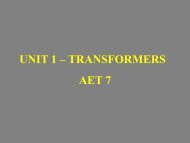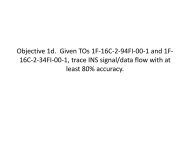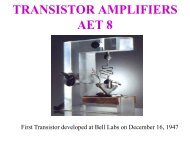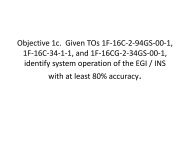Multivibrators - NCATT
Multivibrators - NCATT
Multivibrators - NCATT
You also want an ePaper? Increase the reach of your titles
YUMPU automatically turns print PDFs into web optimized ePapers that Google loves.
<strong>Multivibrators</strong>Chapter 3
Objective 3b• Identify Multivibrator Operating Principles
Square Waveform
Rectangular Waveform
Square Wave with Transient Interval
WAVFORMSRMS• CYCLE- a waveform which undergoes apattern of changes, returns to its originalvalue, and repeats the same pattern ofchanges, is called a periodic waveform.Each completed pattern is called a CYCLE.• Period- the time of each alternation iscalled the period, duration, time, orlength.
WAVEFORMS• Pulse time- 1 alternation is called the pulse orthe gate.• Rest time- the off time.• Pulse recurrence time(PRT)- the pulse timeplus the rest time (time for one cycle).• Pulse recurrence frequency(PRF)-equals onedivided by the PRT.
WAVEFORMS• Rise time- the time required for the voltage orcurrent to build up from the 10 percent pointto the 90 percent point.• Fall time- the time required to drop from the90 percent point to the 10 percent point.
WAVEFORMS• Pulse width- the duration of the pulse and isoften measured between points representing70.7 percent of peak amplitude.
Transistor with switch and itsoutputs
ASTABLE MULTIVIBRATOR• PURPOSE – Astable has no stable state. Itchanges in a continuous free running mannerdue to its crossover coupling. The Astatblemultivibrator does not require an AC input tooperate.• Generates square or rectangular waveforms• Two outputs 180° out of phase
Astable MultivibratorIf Q1ONSaturatedThenQ2OFFCutoff
Astable Multivibrator•Q1 AND Q2- transistor switches•R1 and R10- collector loadresistors for Q1 and Q2.•R3 and R9- limit the charge timeof C3 and C4.•R5, R6, R7, R8- determine thedischarge time of C3 and C4.
Astable Multivibrator•R5- also serves as frequencyadjustment.•R6- also serves as symmetryadjustment.•D1 and D3- isolate thecollectors of Q1 and Q2.
Q1 ConductingC3 discharges through R7, R6, R5,Q1 and D1 holding Q2 cutoff andC4 charges through R9
Q2 ConductingC3 charges through R3 and C4discharges through R8, R6, R5, Q2and D2 holding Q1 cutoff
Q1Outputs180° out ofphaseQ2
Adjusting R5Frequency Adjust
Astable Multivibrator• Increasing the value (resistance) of R 5- The RCtime constant for both C 3and C 4increasescausing the circuit PRT to increase and PRF todecrease. Decreasing the resistance of R5 willhave the opposite effect on the circuit PRT.
Adjusting R6Symmetry AdjustQ2C3
Astable Multivibrator• Adjusting R 6to the right decreases the RC timeconstant for C 4and increases the RC time constantfor C 3. The astable multivibrator will produce arectangular output because Q 2conducts less and Q 1conducts longer. This will not effect the circuit PRTbecause the overall RC time constant was notchanged. Adjusting R6 to the left will have theopposite effect.
MONOSTABLE MULTIVIBRATOR• PURPOSE - A widely used multivibratorcircuit, which never becomes free-running andmust always be triggered for each outputpulse. Also known as a start-stop or a one shotmultivibrator.• Produces square or rectangular waveforms• One output pulse for every input trigger
Monostable Multivibrator
Monostable Multivibrator•R1 and R4- collector load resistorsfor Q1 and Q2. R4 is used to developthe output of Q2.•C1, R2, time constant circuit used tocontrol the width of the output pulse.•C2- input coupling capacitor.
Monostable Multivibrator•R3, R4, AND R5- biasing resistorsfor Q1.•R2- biasing resistor for Q2.•D1- isolate the base of Q1 fromunwanted triggers.•Q1 and Q2- transistor switches.
Static (Quiescent) condition Q1 is cutoff and Q2 isconducting, C1 will charge through R1OFFON
A positive trigger will cause Q1 to conduct, whichallows C1 to discharge through R2, causing Q2 to gointo cutoffONOFF
The output of Q2 is fed back to the base of Q1 to hold Q1 ONallowing C1 to fully discharge through R2 (5 RC TimeConstants)ONOFF
The discharge of C1 through R2 determines the outputpulse width (T1 – T2)ONOFF
Adjusting R2(Pulse Width)
If the value of R2 increases, then theRC time constant increases. The timebetween T1-T2 will increase and thetime between T2-T3 will decrease.
BISTABLE MULTIVIBRATOR• Purpose – Bistable can produce square orrectangular waves depending on the timebetween inputs. Output is normally asquare wave.• Also used as a frequency divider outputfrequency is one-half the input frequency.Two pulses in, one pulse out.• Also known as a Flip-Flop
BISTABLE MULTIVIBRATOR• Requires input trigger to change states• Will stay in last switch state until trigger• Width of the output pulses is determinedby the PRT of the input triggers
BISTABLE MULTIVIBRATOR• Q1 and Q2- transistor switches, alternatelysaturated and cutoff.• R1 and R4 - collector load resistors for Q1and Q2.• R3, R4, and R5 - bias network for Q1.• R1, R2, and R6 - bias network for Q2.
BISTABLE MULTIVIBRATOR• C1 and C2- ensures faster switching when aninput signal is applied.Helps decrease transientinterval time.• C3 and C4- couples the input signal to thecircuit via steering diodes.• D1 and D2- steering diodes used to route theinput trigger pulse to the proper transistor atthe proper time.• R7 and R8 - feedback network for the biasingof D1 and D2.
Q1 Conducting, Q2 Cutoff, Q2 output highholding Q1 ON, Q1 output low holding Q2cutoffONOFF
Negative input trigger cuts Q1 off, Q1output goes high turning Q2 ON, Q2 outputgoes low holding Q1 cutoffOFFON
Trigger onDown ClockOutput
Bistable MultivibratorTwo input triggersto get one outputpulse
SUMMARY 3bIdentified multivibrator operating principles.• Astable Multivibrator• Monostable Multivibrator• Bistable Multivibrator
MULTIVIBRATORSAPPRAISALS
1. If the positive alternation of a squarewave is 100 usec in duration, thenthe PRF is:a. 5 KHz.b. 10 KHz.c. 50 KHz.d. 100 KHz.
2. What type of output waveform is produced byan astable multivibrator?a. Sine waveb. Sawtoothc. Square wave
3. The astable multivibrator is a:a. sweep generator.b. divide by two circuit.c. time base generator.d. free running oscillator.
4. What is the discharge path for capacitor C3?a. Q1 and R9b. Q2 and R3c. R7, R6, R5, Q1, and D1d. R8, R6, R5, Q2, and D3
5. The components that control the time between t0 and t1are:a. C3, R7, R6 and R5b. C4, R8, R6 and R5c. C4 and R9d. C3 and R10
6. In the astable multivibrator, moving the arm of R6 to theright will:a. decrease Q1 cutoff time.b. decrease Q2 cutoff time.c. decrease discharge time of C3.d. increase discharge time of C4.
7. Increasing the resistance of R5 will cause the astablemultivibrator output PRT to ____ and PRF to ____.a. increase; increaseb. increase; decreasec. decrease; decreased. decrease; increase
8. The monostable multivibrator output PRF isdetermined by the:a. input trigger frequency.b. width of the input trigger.c. cutoff time of Q1 and Q2.d. discharge time of C1 and R2.
9. What is the quiescent(stable) state of Q1and Q2 before theyare triggered?a. Q1 On; Q2 Onb. Q1 On; Q2 Offc. Q1 Off; Q2 Offd. Q1 Off; Q2 On
10. The discharge pathfor capacitor C1 isthrough:a. R1, Vcc, Q1.b. R2, Vcc, Q1.c. Q2, R4, Vcc.d. Q2, R3, R5.
11. If the input PRF increased, then the time between T1-T2will ______ and the time between T2-T3 will ______.a. remain the same; decreaseb. increase; decreasec. remain the same; increased. decrease; increase
12. If the resistance of R2 is decreased, then the time betweenT1-T2 will ______ and the time between T2-T3 will _______.a. decrease; increaseb. increase; decreasec. increase; decreased. decrease; decrease
13. The bistable multivibrator is also known as a:a. flip-flop.b. single shot.c. ramp generator.d. subtract by two circuit.
14. If the positive alternation of the bistablemultivibrator output cycle is equal to 200microseconds, then the multivibrator inputPRF is:a. 1.25 kHz.b. 2.5 KHz.c. 5 KHz.d. 10 KHz.
15. What determines the width of the output pulses ina bistable multivibrator?a. Discharge of C1 and C2b. PRT of input triggersc. Charge time of C1 and C2d. RC time constant of C1 and R6
16. If the input PRF to the bistable multivibrator is100 KHz, then the output PRT is:a. 2.5 usec.b. 5 usec.c. 10 usec.d. 20 usec.
Appraisal Answers1. A 9. D2. C 10. B3. D 11. A4. C 12. A5. B 13. A6. A 14. C7. B 15. B8. A 16. D
The End
















